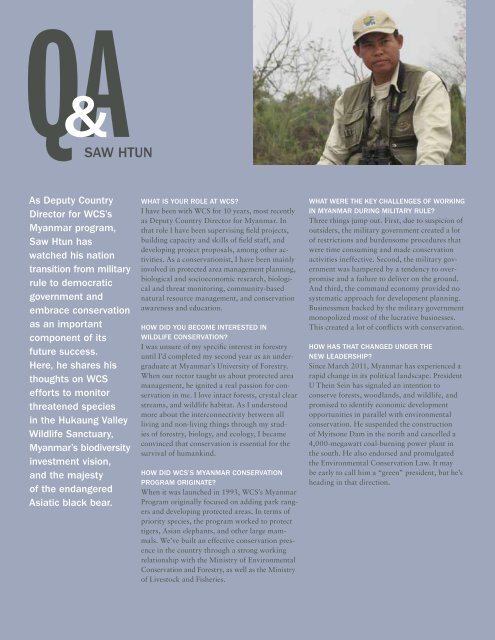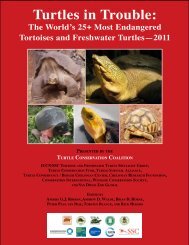WCS Annual Report 2012 - Wildlife Conservation Society
WCS Annual Report 2012 - Wildlife Conservation Society
WCS Annual Report 2012 - Wildlife Conservation Society
Create successful ePaper yourself
Turn your PDF publications into a flip-book with our unique Google optimized e-Paper software.
Saw Htun<br />
As Deputy Country<br />
Director for <strong>WCS</strong>’s<br />
Myanmar program,<br />
Saw Htun has<br />
watched his nation<br />
transition from military<br />
rule to democratic<br />
government and<br />
embrace conservation<br />
as an important<br />
component of its<br />
future success.<br />
Here, he shares his<br />
thoughts on <strong>WCS</strong><br />
efforts to monitor<br />
threatened species<br />
in the Hukaung Valley<br />
<strong>Wildlife</strong> Sanctuary,<br />
Myanmar’s biodiversity<br />
investment vision,<br />
and the majesty<br />
of the endangered<br />
Asiatic black bear.<br />
What is your role at <strong>WCS</strong>?<br />
I have been with <strong>WCS</strong> for 10 years, most recently<br />
as Deputy Country Director for Myanmar. In<br />
that role I have been supervising field projects,<br />
building capacity and skills of field staff, and<br />
developing project proposals, among other activities.<br />
As a conservationist, I have been mainly<br />
involved in protected area management planning,<br />
biological and socioeconomic research, biological<br />
and threat monitoring, community-based<br />
natural resource management, and conservation<br />
awareness and education.<br />
How did you become interested in<br />
wildlife conservation?<br />
I was unsure of my specific interest in forestry<br />
until I’d completed my second year as an undergraduate<br />
at Myanmar’s University of Forestry.<br />
When our rector taught us about protected area<br />
management, he ignited a real passion for conservation<br />
in me. I love intact forests, crystal clear<br />
streams, and wildlife habitat. As I understood<br />
more about the interconnectivity between all<br />
living and non-living things through my studies<br />
of forestry, biology, and ecology, I became<br />
convinced that conservation is essential for the<br />
survival of humankind.<br />
How did <strong>WCS</strong>’s Myanmar conservation<br />
program originate?<br />
When it was launched in 1993, <strong>WCS</strong>’s Myanmar<br />
Program originally focused on adding park rangers<br />
and developing protected areas. In terms of<br />
priority species, the program worked to protect<br />
tigers, Asian elephants, and other large mammals.<br />
We’ve built an effective conservation presence<br />
in the country through a strong working<br />
relationship with the Ministry of Environmental<br />
<strong>Conservation</strong> and Forestry, as well as the Ministry<br />
of Livestock and Fisheries.<br />
What were the key challenges of working<br />
in Myanmar during military rule?<br />
Three things jump out. First, due to suspicion of<br />
outsiders, the military government created a lot<br />
of restrictions and burdensome procedures that<br />
were time consuming and made conservation<br />
activities ineffective. Second, the military government<br />
was hampered by a tendency to overpromise<br />
and a failure to deliver on the ground.<br />
And third, the command economy provided no<br />
systematic approach for development planning.<br />
Businessmen backed by the military government<br />
monopolized most of the lucrative businesses.<br />
This created a lot of conflicts with conservation.<br />
How has that changed under the<br />
new leadership?<br />
Since March 2011, Myanmar has experienced a<br />
rapid change in its political landscape. President<br />
U Thein Sein has signaled an intention to<br />
conserve forests, woodlands, and wildlife, and<br />
promised to identify economic development<br />
opportunities in parallel with environmental<br />
conservation. He suspended the construction<br />
of Myitsone Dam in the north and cancelled a<br />
4,000-megawatt coal-burning power plant in<br />
the south. He also endorsed and promulgated<br />
the Environmental <strong>Conservation</strong> Law. It may<br />
be early to call him a “green” president, but he’s<br />
heading in that direction.







![RaLand / SeaScape [PDF] - Wildlife Conservation Society](https://img.yumpu.com/49974326/1/190x245/raland-seascape-pdf-wildlife-conservation-society.jpg?quality=85)









